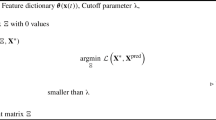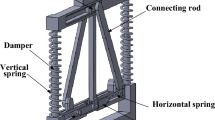Abstract
As modal parameters are the essential features of structural operational condition, the automated structural modal identification technique is currently driving a strong interest in the field of vibration-based structural health monitoring (SHM). This task is highly judgmental, with user expertise playing an important role as to which estimated mode is being selected. To simplify the identification procedure and improve the identification accuracy, this paper presents an innovative stabilization diagram for operational modal analysis (OMA) based on Natural excitation technique (NExT)/eigensytem realization algorithm (ERA) and hierarchical cluster analysis. It consists of three key steps: (1) Physical modes are filtered preliminarily by a novel distance index based on output matrix from Consistent Mode Indicator (CMI_O); (2) Hierarchical clustering analysis is developed for automatic interpretation of the traditional stabilization diagram; (3) Thompson-Tau technique and a regrouping procedure are introduced for further screening outliers to improving the identification accuracy. Numerically generated data, experimental data obtained from a four-layer structure in the lab and field monitored data from a super high-rise structure are used to verify the applicability and reliability of the proposed method. The results show that the proposed method is able to identify physical modes in high accuracy even with noise interference, enabling the detection of good flexibility and practicability. Furthermore, none of user-defined parameter and less expert experience is demanded for the improved method.
























Similar content being viewed by others
References
Rainierin C, Fabbrocino G (2016) Development and validation of an automated operational modal analysis algorithm for vibration-based monitoring and tensile load estimation. Mech Syst Signal Process 60–61:512–534
Diord S, Magalhaes F, Cunha A et al (2017) Automated modal tracking in a football stadium suspension roof for detection of structural changes. Struct Control Health Monit 24(11):e2006.1-e2006.19
Yi TH, Li HN, Wang CW (2016) Multiaxial sensor placement optimization in structural health monitoring using distributed wolf algorithm. Struct Control Health Monit 23(4):719–734
Torres W, Almazán JL et al (2017) Operational modal analysis and FE model updating of the Metropolitan Cathedral of Santiago, Chile. Eng Struct 143:169–188
Gaebler KO, Hedegaard BD, Shield CK et al (2018) Signal selection and analysis methodology of long-term vibration data from the I-35W St. Anthony Falls Bridge. Struct Control Health Monit 25(7):e2182.1-e2182.15
Yang XM, Yi TH, Qu CX et al (2020) Modal identification of high-speed railway bridges through free-vibration detection. J Eng Mech 146(9):04020107
Bendat JS, Piersol AG (1980) Engineering applications of correlation and spectral analysis. Wiley-Interscience, New York, p 315
Prevosto M (1982) Algorithmes d’identification des caractéristiques vibratoires de structures mécaniques complexes. PhD thesis, Université de Rennes 1, France, Mar.
Brincker R, Ventura C, Andersen P (2001) Damping estimation by frequency domain decomposition. Proceedings of the 19th International Modal Analysis Conference(IMAC), Hyatt Orlando, Kissimmee, Florida,698–703
Peeters B, De Roeck G, Pollet T, Schueremans L (1995) Stochastic subspace techniques applied to parameter identification of civil engineering structures. Proceeding of New Advances in Modal Synthesis of Large Structures: Nonlinear, Damped and Nondeterministic Cases,Lyon, France: 151–162
James III GH, Carrie TG, Lauffer JP (1993) The natural excitation technique (NExT) for modal parameter extraction from operating wind turbines. Report SAND92–1666,UC-261, Sandia National Laboratories, Albuquerque, New Mexico, USA.
Ibrahim S (1977) Random decrement technique for modal identification of structures. J Spacecr Rocket 14(11):696–700
Ibraham S (1977) A method for the direct identification of vibration parameter from the free responses. Shock Vib Bull 47(4):183–198
Brown DL, Allemang RJ, Zimmerman R, Mergeay M (1979) Parameter estimation techniques for modal analysis. SAE Transactions 88: 828–846
Juang J-N, Pappa RS (1986) Effects of noise on modal parameters identified by the eigensystem realization algorithm. J Guid Control Dyn 9(3):294–303
Juang J-N, Pappa RS (1985) An eigensystem realization algorithm for modal parameter identification and model reduction. J Guid Control Dyn 8(5):620–627
Qu CX, Yi TH, Yang XM et al (2017) Spurious mode distinguish by eigensystem realization algorithm with improved stabilization diagram. Struct Eng Mech 63(6):743–750
Au SK (2016) Model validity and frequency band selection in operational modal analysis. Mech Syst Signal Process 81(Dec):339–359
Wang T, Celik O, Catbas FN et al (2016) A frequency and spatial domain decomposition method for operational strain modal analysis and its application. Eng Struct 114:104–112
Hasan MDA, Ahmad ZAB, Leong MS et al (2019) Cluster analysis for automated operational modal analysis: a review MATEC web of conferences. EDP Sci 255:02012
Yi TH, Yao XJ, Qu CX, Li HN (2019) Clustering number determination for sparse component analysis during output-only modal identification. J Eng Mech-Asce 145(1):04018122
Pappa RS, James GH, Zimmerman DC (1998) Autonomous modal identification of the space shuttle tail rudder[J]. J Spacecr Rocket 35(2):163–169
Chauhan S, Tcherniak D (2008) Clustering approaches to automatic modal parameter estimation. Proceedings of the 27th International Modal Analysis Conference (IMAC), Orlando, Florida, USA,14–28
Magalhaes F, Cunha A, Caetano E (2009) Online automatic identification of the modal parameters of a long span arch bridge. Mech Syst Signal Process 23(2):316–329
Phillips AW, Allemang RJ, Brown DL (2011) Autonomous modal parameter estimation: methodology. Modal analysis topics, vol 3. Springer, New York, pp 363–384
Reynders E, Houbrechts J, De Roeck G (2012) Fully automated (operational) modal analysis. Mech Syst Signal Process 29:228–250
Zhang G, Ma J, Chen Z et al (2014) Automated eigensystem realization algorithm for operational modal analysis. J Sound Vib 333(15):3550–3563
Cheynet E, Jakobsen JB, Snæbjörnsson J (2016) Buffeting response of a suspension bridge in complex terrain. Eng Struct 128:474–487
Cardoso R, Cury A, Barbosa F (2017) A robust methodology for modal parameters estimation applied to SHM. Mech Syst Signal Process 95:24–41
Cardoso R, Cury A, Barbosa F (2018) A clustering-based strategy for automated structural modal identification. Struct Health Monit 17(2):201–217
Yang XM, Yi TH, Qu CX et al (2018) Automated eigensystem realization algorithm for operational modal identification of bridge structures. J Aerosp Eng 32(2):04018148
Neu E, Janser F, Khatibi AA et al (2017) Fully automated operational modal analysis using multi-stage clustering. Mech Syst Signal Process 84:308–323
Yaghoubi V, Vakilzadeh MK, Abrahamsson TJS (2018) Automated modal parameter estimation using correlation analysis and bootstrap sampling. Mech Syst Signal Process 100:289–310
Teng J, Tang DH, Zhang X, et al. (2019) Automated modal analysis for tracking structural change during construction and operation phases. Sensors 19(4):927
Ye X, Yan Q, Wang W et al (2012) Modal identification of Canton Tower under uncertain environmental conditions. Smart Struct Syst 10(4_5):353–373
Pan C, Ye X, Mei L (2021) An improved automatic operational modal analysis method and application to large-scale bridges. J Bridg Eng. https://doi.org/10.1061/(ASCE)BE.1943-5592.0001756
Pappa RS, Elliott KB (1993) Consistent-mode indicator for the eigensystem realization algorithm. J Guid Control Dyn 16(5):852–858
Yun GJ, Lee SG, Shen S (2012) An improved mode accuracy indicator for eigensystem realization analysis (ERA) techniques. KSCE J Civ Eng 16(3):377–387
Cabboi A, Magalhaes F, Gentile C et al (2016) Automated modal identification and tracking: application to an iron arch bridge. Struct Control Health Monit 24(1):1854
Mao J, Wang H, Fu Y, et al. (2019) Automated modal identification using principal component and cluster analysis: application to a long-span cable-stayed bridge. Struct Control Health Monit 26(10):e2430
Pecorelli ML, Ceravolo R, Epicoco R (2018) An automatic modal identification procedure for the permanent dynamic monitoring of the sanctuary of vicoforte. Int J Arch Heritage 14(4): 630–644
Yang K, Yu K, Wang H (2020) A hybrid method of multi-objective particle swarm optimization and k-means clustering and its application to modal parameter estimation in the time–frequency domain. J Vib Control 26(9–10):769–778
Shen Q, Yang R (2016) Thompson-Tau outlier detection method for detecting abnormal data of listed pharmaceutical companies in China. The 8th International Symposium on Computational Intelligence and Design (ISCID),Hangzhou, China,15988194
Ni YQ, Xia Y, Lin W, et al. (2012) SHM benchmark for high-rise structures: a reduced-order finite element model and field measurement data. Smart Struct Syst 10(4–5):411–426
Acknowledgements
The work described in this paper was financially supported by the National Natural Science Foundation of China (Grant No. 51608136 and 51908149), Shenzhen Science Technology and Innovation Commission (SZSTI) Basic Research General Program (Grant No. JCYJ20190808154411663), and Guangdong Provincial Key Laboratory of Durability for Marine Civil Engineering (SZU) (Grant No. 2020B1212060074), for which, the writers are grateful. The authors thank all the reviewers and editors for their significant help and useful suggestions.
Author information
Authors and Affiliations
Corresponding author
Ethics declarations
Conflict of interest
The authors confirm that this article content has no conflict of interest.
Additional information
Publisher's Note
Springer Nature remains neutral with regard to jurisdictional claims in published maps and institutional affiliations.
Rights and permissions
About this article
Cite this article
Ye, X., Huang, P., Pan, C. et al. Innovative stabilization diagram for automated structural modal identification based on ERA and hierarchical cluster analysis. J Civil Struct Health Monit 11, 1355–1373 (2021). https://doi.org/10.1007/s13349-021-00514-8
Received:
Revised:
Accepted:
Published:
Issue Date:
DOI: https://doi.org/10.1007/s13349-021-00514-8




